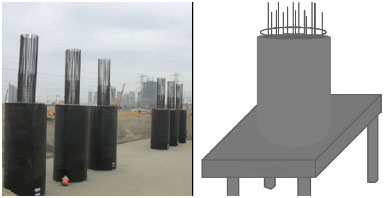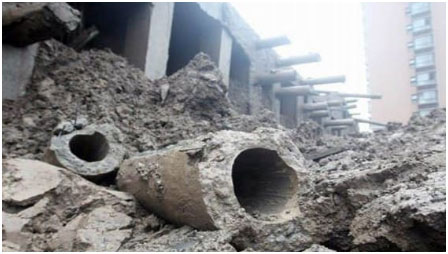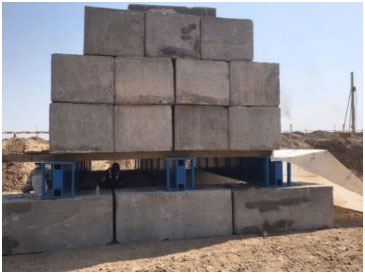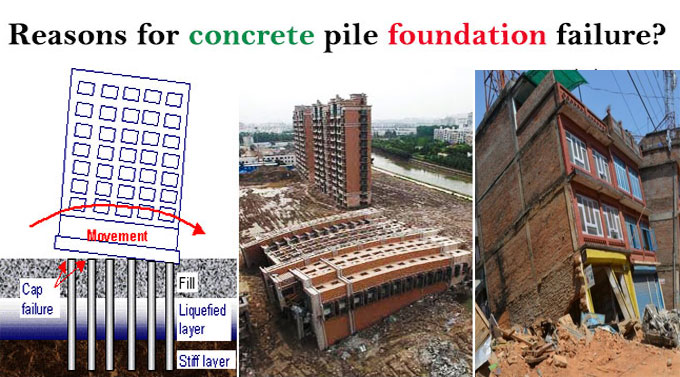
Causes of Pile Foundation Failure
Concept about Pile Foundation: Definition and Functions
Pile Foundation is used in construction projects to support the heavy loads of the buildings and also transfer the building loads deeper into the soil. Piles act as the sturdy pillars in building structures including bridges, buildings, and other large constructions, and distribute the loads of those large buildings vertically. Thus, the excessive settlement of those large constructions or movements of those buildings has been prevented by the Pile Foundations. In this regard, the failure of the Pile foundation leads to damage to the building constructions which can be mitigated by understanding the reasons behind the pile foundation failure.

Figure 1: Pile Foundation
Reasons for the failure of the Pile Foundation
There are numerous causes that significantly lead to the failure of the pile foundations.

Figure 2: Pile foundation failure
The presence of a hard stratum below the pile-toe
The hard stratum including the rock stratum should have the capacity to support and sustain the load of the buildings. This rock stratum should be capable of transmitting the building loads by pile tip without failing in settlement and shear. Sometimes, the sound rock’s thin layer overlays the weak rock or unsound rocks and crevices into the rock surface thus affecting the sound rock of the building structures.
Space between pile toe and rock stratum
A sufficient area of contact between the pile supporting stratum and pile toe should be present which helps to transmit the building load from the pile to the supporting stratum below. In some cases, construction ends with the defective pile toe. The improper seating of the pile toe over the supporting rock stratum also has been seen which leads to the occurrence of the high order of settlements. Sometimes, large intensities of stress also develop in the pile-toe portion as the surface of the pile-toe concrete is partly in contact with the supporting rock stratum. This results in the crush of the pile toe concrete which leads to an excessive settlement of the pile.
The shaft body of the pile
The pile shaft body acts as the solid column which transfers the load of the construction superstructure to the supporting stratum. In the case of faulty concreting, defects have been seen in the cast-in-situ piles. The poor quality of the pile body has been produced by the use of improper mix designs or deleterious concrete materials.
Nature of the junction of the pile cap, pile top, and super-structural column
All the piles are eccentrically positioned during the construction procedures. The impact of the eccentricities is greater in those areas where the piles are laid on the hard stratum or in those places where the casing pipes are removed after the concreting of the piles or in the meantime of the construction process.
The presence of chemical aggressiveness in the sub-soil water
In the case of presenting aggressive chemicals including water-soluble sulphates or chlorides in an excessive amount (more than permissible limits) within the sub-soil water, the cast-in-situ concrete has been negatively affected. The presence of chemical aggressiveness also may corrode the pile body reinforcement leaving behind a useless pile. The function regarding the transformation of the building load from the building superstructure to the hard stratum has been also a concern due to the chemical aggressiveness of the sub-soil water.
Drag on pile body
Clayey soils or recent fills induce a drag on the pile body. This type of downward drag is the reason for the pile foundation failures in the reclaimed areas.
Exceeding the load capacity
In the case of the actual load of the building structure on the piles exceeding the design capacity of the piles, the pile foundation may fail. Higher leads than the load-bearing capacity lead to structural failure as piles are designed for bearing specific loads.

Figure 3: Pile load test
Poor workmanship during pile casting
Poor and defective workmanship including inaccurate concrete mixing or lack of supervision leads to defective pile structures which results in pile foundation failure.
Improper soil characterization
It is needs to understand the characteristics of the soil character in the construction units. It is crucial to design the appropriate pile foundation for that soil. The improper characterization of the soil leads to the improper selection of the pile lengths or types which leads to inadequate load-bearing capacity by those piles and leads to failure of the pile foundation.
Improper pile-type selection
Different types of piles are appropriate for different types of load requirements and different types of soil conditions. In this context, the selection of the wrong pile types leads to the inadequate performance of the piles and leads to the eventual failure of the pile foundation.
Incorrect determination of load-bearing capacity
The load-bearing capacity of the piles should also determined accurately. It is important to ensure that the intended load has been supported by that particular pile. In case of overestimating the load-bearing capacity of the pile, the pile foundation may fail under load.
Negative consequences of pile foundation failure
Pile foundation failure has severe consequences for the construction structures. The failure of the pile foundation leads to excessive settlement and uneven subsidence of the building structures. This incidence may compromise the overall building stability or may damage the building structure. Failed pile structures need expensive remedial measures to address the issues that impact the financial and time considerations of the construction projects.
Remedies for preventing pile foundation failure
Several remedial measures can be taken to prevent pile foundation failure which includes prompting corrective actions like replacement of the pile foundation, removal of the partial load, and implementing underpinning measures.
To get more details, watch the following video tutorial.
Video Source: Amazing Engineering | ACES


